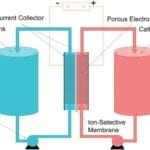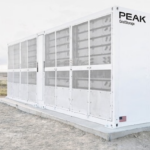Lithium-ion (Li-ion) is the most commonly talked about battery storage technology on the market these days, and for good reason. Li-ion batteries have a high energy density, and they are the preferred option when mobility is a concern, such as for cell phones, laptop computers, and electric vehicles. But there are different energy storage technologies that make more sense in other use cases. For example, iron flow batteries may be a better option for utility-scale power grid storage.
An iron flow battery is built with three pretty simple ingredients: iron, salt, and water. “A flow battery has a tank with an electrolyte—think of it as salt water to be simple—and it puts it through a process that allows it to store energy in the iron, and then discharge that energy over an extended period of time,” Eric Dresselhuys, CEO of ESS Inc., a manufacturer of iron flow batteries for commercial and utility-scale energy storage applications, explained as a guest on The POWER Podcast.
Iron flow batteries have an advantage over utility-scale Li-ion storage systems in the following areas:
- Longer duration. Up to 12 hours versus a typical duration of no more than 4 hours for large-scale Li-ion systems.
- Increased safety. Iron flow batteries are non-flammable, non-toxic, and have no explosion risk. The same is not true for Li-ion.
- Longer asset life. Iron flow batteries offer unlimited cycle life and no capacity degradation over a 25-year operating life. Li-ion batteries typically provide about 7,000 cycles and a 7- to 10-year lifespan.
- Less concern with ambient temperatures. Iron flow batteries can operate in ambient conditions from –10C to 60C (14F to 140F) without the need for heating or air conditioning. Ventilation systems are almost always required for utility-scale Li-ion systems.
- Lower levelized cost of storage. Because iron flow batteries offer a 25-year life, have a capital expense cost similar to Li-ion, and operating expenses that are much lower than Li-on, the cost of ownership can be up to 40% less.
“People have been really interested in flow batteries for a lot of reasons, but the most common one that you’ll hear about is the long duration,” said Dresselhuys.
So, why haven’t iron flow batteries overtaken Li-ion batteries in the power grid storage market? “I think lithium has had an advantage for a couple of reasons historically,” Dresselhuys said. “The first is that it’s been more broadly available.”
Dresselhuys explained that even though Li-ion batteries weren’t specifically developed for grid applications, the fact that they are well-suited for cars and other uses, where the energy density that lithium provides has real advantages, allowed manufacturing efficiencies to develop. That, in turn, has brought costs for Li-ion down and accelerated growth. Therefore, it’s taken some time for other technologies to catch up.
Still, there are companies implementing iron flow battery projects. ESS announced in April that it had contracted with a Chilean utility to provide a flow battery system for use in the environmentally pristine Patagonia area. ESS’s 300-kW/2-MWh Energy Warehouse system will be integrated with renewable resources in a local microgrid with the aim of eliminating about 75% of the diesel-fueled generation previously used to power the area.
“The project there was actually originally designed and spec’d out to be a lithium project, because, of course, that’s what people thought was available,” said Dresselhuys. ESS’s team of experts talked to the owners about the advantages of the iron flow battery system and came away with the order.
To hear the full interview, which includes more detail about the benefits of iron flow batteries and insight on improvements ESS has made to the technology, listen to The POWER Podcast. Click on the SoundCloud player below to listen in your browser now or use the following links to reach the show page of your favorite podcast platform:
For more power podcasts, visit The POWER Podcast archives.
—Aaron Larson is POWER’s executive editor (@AaronL_Power, @POWERmagazine).










